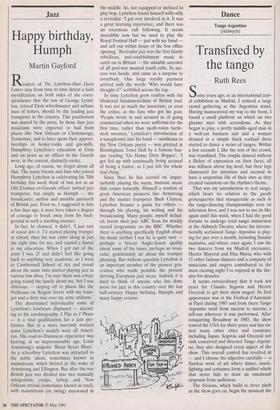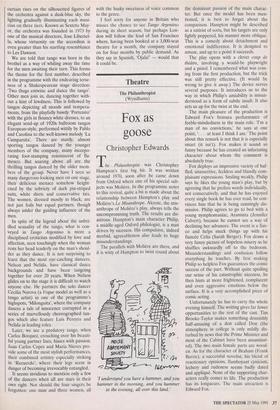Dance
Transfixed by the tango
Ruth Rees
Some years ago, at an international trav- el exhibition in Madrid, I noticed a large crowd gathering at the Argentina stand. Having manoeuvred my way to the front, I found a small platform on which sat two gloomy men with accordions. As they began to play, a portly middle-aged man in a well-cut business suit and a woman dressed in a simple black cocktail dress started to dance a series of tangos. Within a few seconds I, like the rest of the crowd, was transfixed. The couple danced without a flicker of expression on their faces; all was stillness above hip level, but their legs clamoured for attention and seemed to have a serpentine life of their own as they created variations on the rhythm's theme.
That was my introduction to real tango, which bears no relation to the gaudy grotesqueries that masquerade as such in the tango-dancing championships seen on television here, and I was not to see its like again until this week, when I had the good fortune to undergo total tango immersion at the Aldwych Theatre, where the interna- tionally acclaimed Tango Argentine is play- ing for just over a month, including Sunday matinees, and where, once again, I saw the two dancers from my Madrid encounter, Hector Mayoral and Elsa Maria, who with 15 other famous dancers and a company of musicians and singers contributed to the most exciting night I've enjoyed at the the- atre for decades.
It seems extraordinary that it took ten years for Claudio Segovia and Hector Orezzoli to get their show staged. Its first appearance was at the Festival d'Automne in Paris during 1983 and from there Tango Argentino went from success to success, a sell-out wherever it was performed. After conquering Broadway in 1985, the show toured the USA for three years and has vis- ited many other cities and countries, including Japan. Segovia and Orezzoli not only conceived and directed Tango Argenti- no, they also designed every aspect of the show. This overall control has resulted in — and I choose the adjective carefully — a flawless work of art where dance, music, lighting and costumes form a unified whole that never fails to draw an emotional response from audiences.
The frissons, which build to fever pitch as the show goes on, begin the moment the curtain rises on the silhouetted figures of the orchestra against a dusk-blue sky, the lighting gradually illuminating each musi- cian on three tiers. Known as Sextet() May- or, the orchestra was founded in 1973 by one of the musical directors, Jose Libertel- la, whose virtuosity on the accordion is even greater than his startling resemblance to Les Dawson.
We are told that tango was born in the brothel as a way of whiling away the time for the men awaiting their turn. This forms the theme for the first number, described in the programme with the endearing terse- ness of a Shakespearean stage direction: Two thugs entwine and dance the tango'. Other men join in, dancing together with- out a hint of lewdness. This is followed by tangos depicting all moods and tempera- ments, from the playfully bawdy 'Portenito' with the girls in flouncy white dresses, to an elegant send-up of 1920s ballroom tangos European-style, performed wittily by Pablo and Carolina to the well-known melody la Cumparsita'. There are sturdy, almost sporting tangos danced by the younger members of the company, many incorpo- rating foot-stamping reminiscent of fla- menco. But soaring above all are the thrilling tangos danced by the older mem- bers of the group. Never have I seen so many dangerous-looking men on one stage, their delicious menace somehow height- ened by the sobriety of dark pin-striped suits, white shirts and conservative ties. The women, dressed mostly in black, are not just foils but equal partners, though always under the guiding influence of the men.
In spite of the legend about the unbri- dled sexuality of the tango, what is con- veyed in Tango Atgentino is more a disciplined eroticism modified by love and affection, seen touchingly when the woman rests her head tenderly on the man's shoul- der as they dance. It is not surprising to learn that the most eye-catching dancers, Nelson and Nelida, have classical dance backgrounds and have been tangoing together for over 20 years. When Nelson glides on to the stage it is difficult to watch anyone else. He partners the solo dancer Cecilia Narova (a Vogue model as well as a tango artist) in one of the programme's highspots, `Milonguita', where the company dances a tale of innocence corrupted in a series of marvellously choreographed tan- gos which also feature Luis Pereyra and Nelida in leading roles.
Later, we see a predatory tango, when Carlos Borquez, crouching over his beauti- ful young partner Ines, hisses with passion. Juan Carlos Copes and Maria Nieves pro- vide some of the most stylish performances, their combined artistry especially striking in 'Recuerdo', where their legs seem in danger of becoming irrevocably entangled.
It seems invidious to mention only a few of the dancers when all are stars in their own right. Nor should the four singers be forgotten: one man and three women, all with the husky sweetness of voice common to the genre.
I feel sorry for anyone in Britain who misses the chance to see Tango Atgentino during its short season, but perhaps Lon- don will follow the lead of San Francisco where, having been booked at a 3,000-seat theatre for a month, the company stayed on for four months by public demand. As they say in Spanish, 'Ojala!' — would that it could be.



















































 Previous page
Previous page